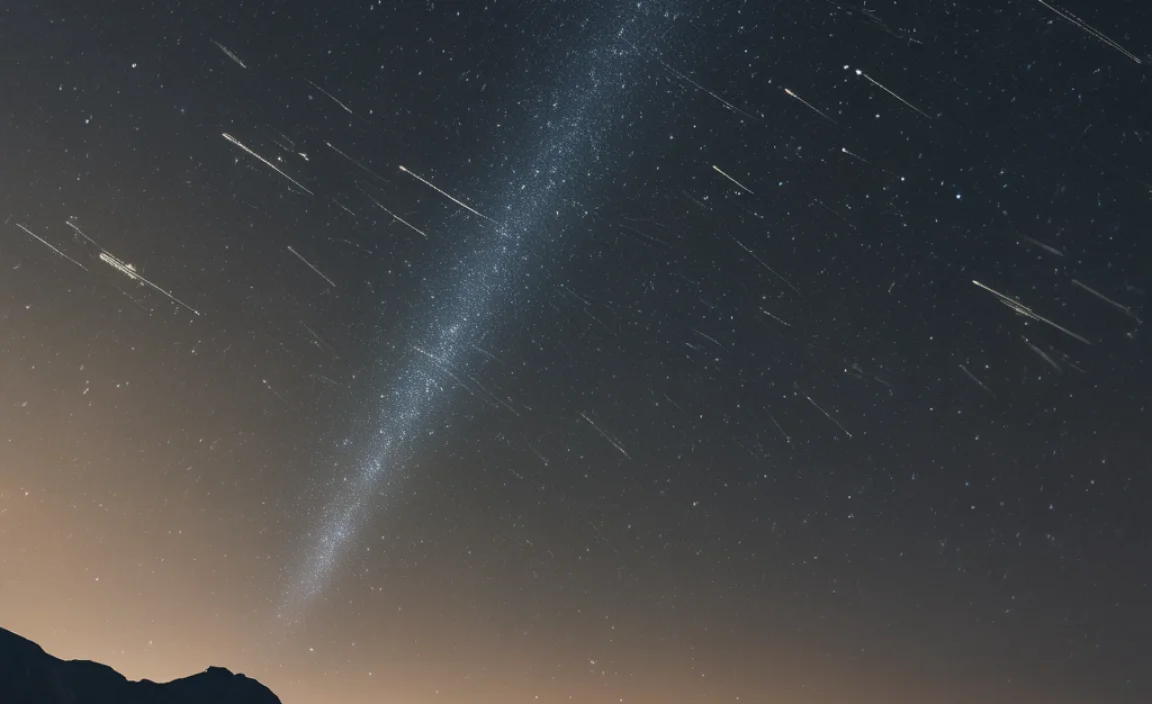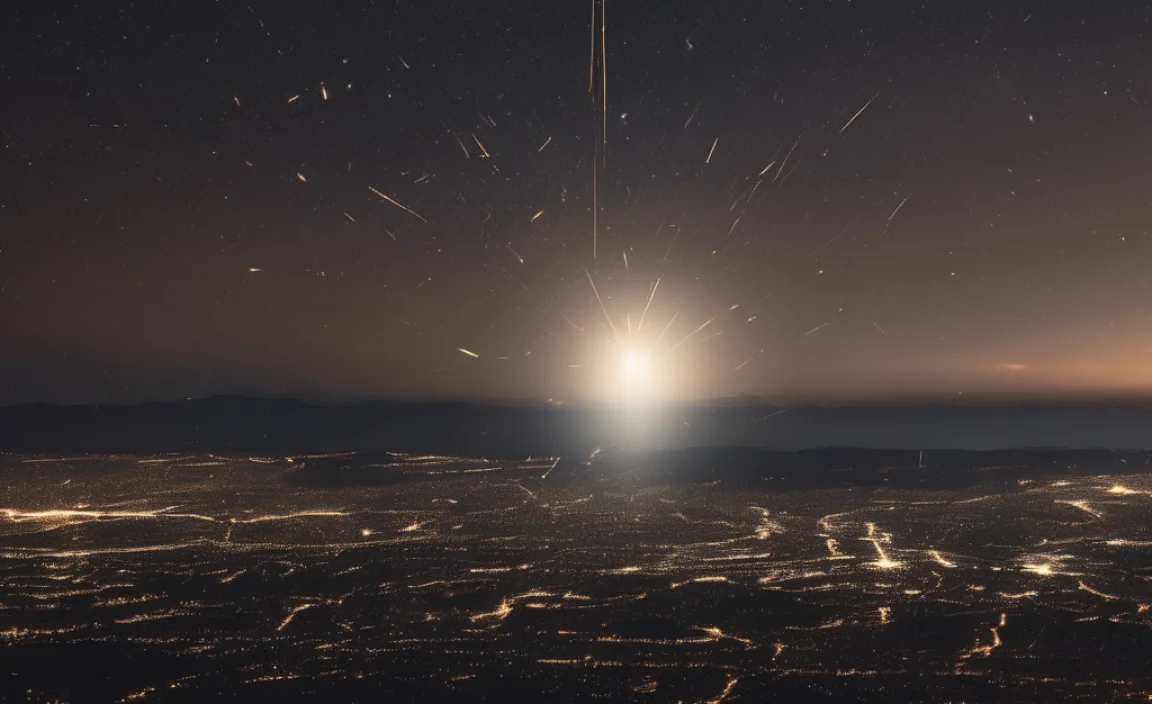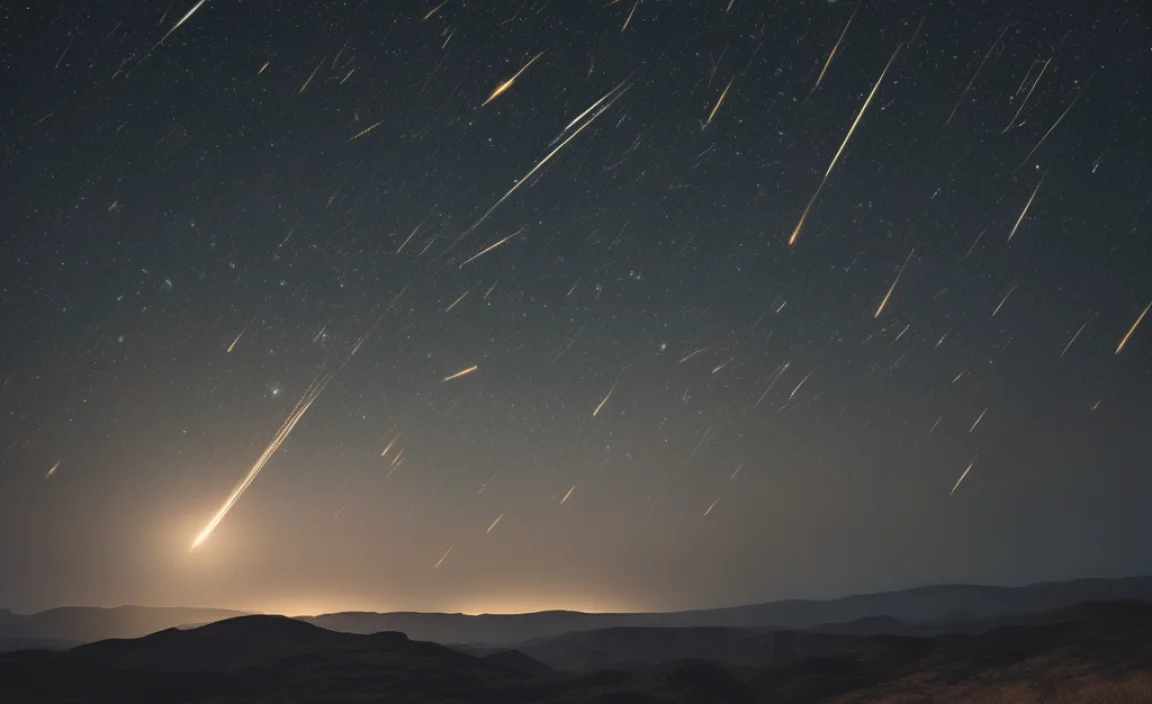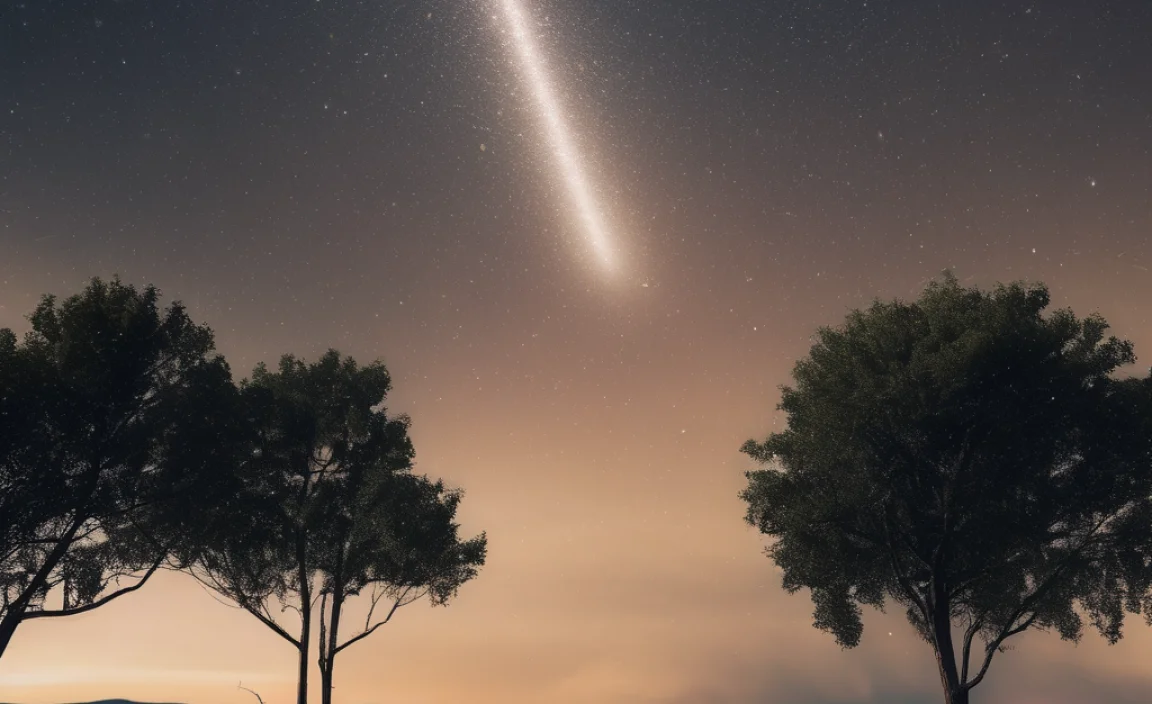Have you ever seen a shooting star? Meteor showers fill the sky with them. They are a beautiful sight. These showers happen each year. Did you know they don’t last forever? So, how long do meteor showers last? Let’s explore this exciting topic.
Key Takeaways
- Major meteor showers can last for several days, even weeks, with varying intensity.
- The peak viewing time is usually just a few hours or a single night.
- Knowing when the peak occurs helps you see the most meteors.
- Some meteor showers are more active and last longer than others.
- Understanding how long do meteor showers last lets you plan your stargazing.
How Long Does a Meteor Shower Typically Last?

Meteor showers are amazing events in the night sky. They happen when Earth passes through a stream of space dust. This dust comes from comets or asteroids. When these tiny bits of rock and ice enter our atmosphere, they burn up. This creates the bright streaks we call meteors. These streaks are also known as shooting stars. But how long do meteor showers last? Most meteor showers last for several days. Some can even last for a few weeks. However, the peak of the shower, when you see the most meteors, is usually much shorter. It often lasts just a few hours or a night. The duration depends on the size and density of the dust stream. It also depends on Earth’s path through it. So, while a shower might be active for a while, the best time to watch is during its peak.
- Meteor showers occur when Earth crosses debris trails.
- The dust comes from comets and asteroids.
- Meteors burn up in Earth’s atmosphere.
- Showers can last days to weeks.
- Peak viewing is usually much shorter.
The length of a meteor shower also depends on the parent comet or asteroid. Some comets leave behind a wide, spread-out trail of debris. This causes a longer-lasting shower. Other comets have a more concentrated trail. This results in a shorter, more intense shower. Also, the angle at which Earth passes through the debris stream matters. A direct hit through the densest part leads to a spectacular peak. A glancing pass may result in a weaker, longer-lasting shower. Knowing these factors helps astronomers predict when the best viewing times will be. It also helps them understand how long do meteor showers last. So, grab a blanket, find a dark spot, and enjoy the show!
Fun Fact or Stat: The longest meteor showers can last for over a month, though the peak is much shorter!
What Factors Affect Shower Duration?
Have you ever wondered why some meteor showers seem to go on forever? Yet others are over in a flash? Several factors play a big role in determining how long do meteor showers last. The first factor is the size of the debris field left by the comet or asteroid. A larger debris field means Earth takes longer to pass through it. This results in a longer shower. The second factor is the density of the debris. A denser field means more meteors per hour. But it doesn’t necessarily mean the shower lasts longer. Another thing is Earth’s speed as it moves through the debris. A faster speed means a shorter passage. Finally, the angle at which Earth intersects the debris stream is crucial. A head-on collision results in a shorter, more intense shower.
Why Does the Peak Viewing Time Matter?
Imagine planning a trip to see something amazing. But you miss the best part. That’s why knowing the peak viewing time for a meteor shower is so important. The peak is when you’re most likely to see the highest number of meteors per hour. During off-peak times, the meteor count can be much lower. This makes the shower less exciting. Astronomers study the orbits of comets and asteroids. They use this information to predict when the peak will occur. This helps stargazers plan their viewing sessions. Understanding how long do meteor showers last and when the peak is will make your experience much better.
How Do Astronomers Predict Shower Length?
Predicting how long do meteor showers last is like solving a cosmic puzzle. Astronomers use complex models and data to make these predictions. They start by studying the orbits of comets and asteroids that cause the showers. They analyze the size and shape of the debris fields. They also consider Earth’s orbit and speed. This helps them estimate when Earth will enter and exit the debris stream. They also look at past observations of the shower. This helps them fine-tune their predictions. It’s not an exact science, but these models provide a good estimate. They allow us to know when to look up and enjoy the show.
Major Meteor Showers and Their Durations

Different meteor showers have different durations. Some are quick and intense. Others are long and drawn out. The Perseids are one of the most famous. They occur in August. This shower can last for several weeks. The peak usually happens around August 12th or 13th. The Geminids are another popular shower. They happen in December. They are known for their bright, slow-moving meteors. This shower lasts for about two weeks. The Leonids, in November, can sometimes produce meteor storms. These storms are rare but spectacular. Most years, the Leonids are a weaker shower. So, how long do meteor showers last? It varies. Each shower has its own unique pattern.
| Meteor Shower | Month of Peak Activity | Typical Duration | Meteor Rate at Peak (per hour) |
|---|---|---|---|
| Perseids | August | Several Weeks | 50-100 |
| Geminids | December | About Two Weeks | 120-150 |
| Leonids | November | Few Days | 10-15 (can be storms) |
| Orionids | October | About One Week | 20-25 |
| Quadrantids | January | Very Short (Few Hours) | 110-120 |
- Perseids peak in mid-August with many meteors.
- Geminids are bright and visible in December.
- Leonids can have meteor storms sometimes.
- Orionids are linked to Halley’s Comet.
- Quadrantids have a very short peak in January.
Understanding these patterns helps you plan your stargazing. For example, if you want a long-lasting shower, the Perseids are a good choice. If you prefer bright meteors, the Geminids are ideal. Keep in mind that light pollution can affect visibility. Dark skies are best for seeing meteor showers. Check the weather forecast too. Clear skies are essential. Also, remember that how long do meteor showers last is just one factor. The intensity of the shower and your viewing location are also important. So, do your research, be prepared, and enjoy the celestial show!
Fun Fact or Stat: The Geminid meteor shower is caused by an asteroid, not a comet!
What Makes the Perseids So Popular?
The Perseids are like the rock stars of meteor showers. They are bright, frequent, and occur during warm summer nights. This makes them a favorite for stargazers. The Perseids happen when Earth passes through debris from Comet Swift-Tuttle. The shower is active for several weeks in July and August. It peaks around mid-August. During the peak, you can see many meteors per hour. These meteors often leave long, glowing trails. The warm weather allows people to comfortably watch the sky for hours. Plus, the Perseids are visible from the Northern Hemisphere. All these factors combine to make the Perseids a must-see event. The consistent activity impacts how long do meteor showers last and how enjoyable they are.
Why Are the Geminids Known for Bright Meteors?
Have you ever seen a meteor that seemed to explode across the sky? That’s what the Geminids are famous for. These meteors are often bright and colorful. They are also slower than meteors from other showers. This makes them easier to spot. The Geminids are caused by an asteroid called 3200 Phaethon. Asteroids are usually made of rock and metal. This makes their debris denser and brighter. The Geminids peak in December. This is a colder time of year. But the bright meteors make it worth bundling up. The unique composition of the debris affects how long do meteor showers last and how bright they appear.
How Do Meteor Storms Affect Duration?
Imagine a meteor shower on steroids. That’s what a meteor storm is like. Meteor storms are rare events. They can produce hundreds or even thousands of meteors per hour. The Leonids are known for producing meteor storms. These storms happen when Earth passes through a very dense part of the comet’s debris trail. The storms don’t necessarily make the shower longer. But they make it much more intense for a short period. These storms are unpredictable. But they are a spectacular sight. The potential for storms influences how long do meteor showers last and how exciting they can be.
Factors Influencing Meteor Visibility

Seeing a meteor shower is not always easy. Several factors can affect how well you can see the meteors. Light pollution is a big problem. City lights can wash out the faint streaks of meteors. Dark skies are best. The phase of the moon also matters. A full moon can make it harder to see meteors. A new moon is ideal. Weather conditions play a role. Clouds can block your view. Clear skies are essential. Your location is important. High altitudes and open spaces offer better views. So, how long do meteor showers last doesn’t matter if you can’t see them. It is vital to consider these things to improve your chances of seeing a good show.
- Light pollution reduces meteor visibility.
- The moon’s phase affects darkness.
- Weather can block your view.
- High altitudes offer clearer skies.
- Open spaces improve the viewing angle.
- Dark locations are crucial for best viewing.
To maximize your chances of seeing a meteor shower, plan ahead. Find a dark location away from city lights. Check the moon phase. Aim for a new moon or a crescent moon. This will provide the darkest skies. Watch the weather forecast. Look for clear skies. Bring a blanket or chair. Get comfortable. Let your eyes adjust to the darkness. This can take about 20-30 minutes. Be patient. Meteors can appear at any time. Knowing how long do meteor showers last helps you plan your viewing session. Most importantly, enjoy the beauty of the night sky. It is a truly amazing experience.
Fun Fact or Stat: Your eyes can become more sensitive to light by up to 10,000 times when fully adjusted to the dark!
How Does Light Pollution Affect Viewing?
Imagine trying to see stars with a flashlight shining in your eyes. That’s similar to what light pollution does. Light pollution is artificial light that brightens the night sky. This makes it harder to see faint objects like meteors. City lights, streetlights, and even lights from houses can contribute to light pollution. The brighter the light pollution, the fewer meteors you’ll see. To escape light pollution, you need to travel to dark locations. These are often far from cities. Dark sky parks are great places to stargaze. Reducing light pollution helps everyone see the night sky better. The presence of light pollution impacts how long do meteor showers last and how much of them you can actually see.
Why Is the Moon Phase Important?
The moon is a beautiful object in the night sky. But it can also be a nuisance for stargazers. The moon’s light can wash out faint meteors. A full moon is the worst offender. It brightens the entire sky. This makes it hard to see anything else. A new moon is the best time to watch meteor showers. During a new moon, the sky is at its darkest. This allows you to see even the faintest meteors. Check the moon phase before planning your viewing session. It can make a big difference. The lunar cycle affects how long do meteor showers last and how visible they are.
What Role Does Weather Play?
Imagine driving to the beach, only to find it’s raining. Weather can ruin any outdoor activity. It certainly affects your ability to see meteor showers. Clouds are the biggest problem. They block your view of the sky. Even a thin layer of clouds can hide meteors. Clear skies are essential for stargazing. Check the weather forecast before heading out. Look for clear skies and low humidity. Sometimes, you might have to drive a bit to find clear skies. But it’s worth it. Good weather greatly influences how long do meteor showers last in your experience.
Best Locations for Meteor Shower Viewing

Where you watch a meteor shower matters. Dark locations away from city lights are best. Rural areas are often good choices. Parks and campgrounds can also offer dark skies. High altitudes can provide clearer views. Open spaces are important. They give you a wide view of the sky. Avoid areas with trees or buildings blocking your view. Some places are designated as dark sky parks. These parks are protected from light pollution. They offer excellent stargazing opportunities. Consider these factors when planning your meteor shower viewing. Knowing how long do meteor showers last is only useful if you have a good spot to see them from.
- Rural areas offer dark skies.
- Parks and campgrounds are good options.
- High altitudes can provide clearer views.
- Open spaces give a wide view.
- Dark sky parks are ideal locations.
To find the best location, do some research. Use online maps to find dark areas near you. Look for areas with low light pollution. Check online forums and astronomy clubs for recommendations. Talk to local stargazers. They can often suggest hidden gems. Visit the location during the day to scout it out. Make sure it’s safe and accessible at night. Bring a friend or family member with you. Stargazing is more fun with company. Remember, the best location is one that offers dark skies, clear views, and a safe environment. It will make the time you spend enjoying how long do meteor showers last even better.
Fun Fact or Stat: The International Dark-Sky Association (IDA) certifies places as International Dark Sky Parks!
Why Are Rural Areas Ideal?
Imagine stepping outside and seeing a sky full of stars. That’s what it’s like in a rural area. Rural areas are far from city lights. This means they have much less light pollution. The night sky is darker and clearer. You can see more stars and fainter objects. Rural areas often have open spaces too. This gives you a wide view of the sky. They are perfect for stargazing. If you want to see a meteor shower, head to the countryside. The dark skies greatly enhance how long do meteor showers last and your enjoyment of them.
What Makes Dark Sky Parks Special?
Dark sky parks are like sanctuaries for stargazers. These parks are protected from light pollution. They have strict rules about outdoor lighting. This helps keep the night sky dark. Dark sky parks offer excellent stargazing opportunities. They often have educational programs and events. They also have telescopes and other equipment for public use. Visiting a dark sky park is a great way to experience the beauty of the night sky. These parks truly make the most of how long do meteor showers last.
How Can High Altitude Improve Viewing?
Have you ever climbed a mountain and noticed how clear the air is? High altitudes offer clearer skies. The air is thinner and drier. This reduces the amount of light that scatters in the atmosphere. You can see more stars and fainter objects. High altitudes are also often further from city lights. This means less light pollution. Mountain tops are great places to watch meteor showers. Just be sure to dress warmly. It can get cold at high altitudes. The clearer skies at higher elevations enhance how long do meteor showers last.
Equipment and Preparation for Viewing

You don’t need a lot of fancy equipment to watch a meteor shower. But some things can make your experience more enjoyable. A blanket or chair is essential for comfort. You’ll be spending a lot of time looking up. Dress warmly. Nights can be cold, even in summer. A flashlight with a red filter is helpful. Red light doesn’t affect your night vision as much. A star chart or astronomy app can help you identify constellations. Binoculars can enhance your view of the Milky Way. Bring snacks and drinks. Stargazing can be hungry work. Understanding how long do meteor showers last helps you decide what to bring for a longer viewing session.
- A blanket or chair for comfort.
- Warm clothing for cold nights.
- A red flashlight to preserve night vision.
- Star charts or astronomy apps.
- Binoculars for a better view.
- Snacks and drinks to stay comfortable.
Before heading out, check the weather forecast. Make sure the skies will be clear. Arrive at your viewing location early. This gives you time to set up and let your eyes adjust to the darkness. Turn off your phone or put it on airplane mode. This reduces distractions. Be patient. Meteors can appear at any time. Relax and enjoy the show. Don’t forget to tell your friends and family about your experience. Stargazing is a great way to connect with nature and appreciate the beauty of the universe. Knowing how long do meteor showers last and planning accordingly will make the whole experience much better.
Fun Fact or Stat: It takes about 20-30 minutes for your eyes to fully adjust to the dark!
Why Is a Red Flashlight Important?
Imagine walking into a dark room after being in bright sunlight. It takes a while for your eyes to adjust. The same thing happens when you’re stargazing. White light can ruin your night vision. Red light, however, doesn’t affect your eyes as much. A red flashlight allows you to see without losing your night vision. You can use it to read star charts or find your way around. You can buy a red flashlight or put red cellophane over a regular flashlight. It’s a simple trick that makes a big difference. Using a red flashlight helps you enjoy how long do meteor showers last by preserving your vision.
How Do Star Charts and Apps Help?
Have you ever looked up at the stars and wondered what you were seeing? Star charts and astronomy apps can help you identify constellations and planets. They show you where to look for specific objects in the sky. Some apps even use your phone’s camera to overlay information on the sky. These tools can enhance your stargazing experience. They make it more educational and engaging. They also help you find the radiant point of meteor showers. Using charts and apps enriches how long do meteor showers last by helping you understand what you’re seeing.
What Snacks and Drinks Are Best?
Stargazing can be a long and chilly activity. It’s important to stay comfortable and energized. Bring snacks and drinks to keep you going. Hot chocolate or tea is perfect for cold nights. Sandwiches, granola bars, and fruit are good snack choices. Avoid sugary drinks. They can give you a quick burst of energy, followed by a crash. Water is always a good idea to stay hydrated. Pack your snacks and drinks in a reusable bag to reduce waste. Staying comfortable enhances how long do meteor showers last and makes the experience more enjoyable.
Capturing Meteor Showers with Photography
Taking photos of meteor showers can be challenging. But it’s also very rewarding. You’ll need a camera that allows you to adjust the settings manually. A tripod is essential to keep the camera steady. A wide-angle lens is ideal for capturing a large portion of the sky. Set your camera to a high ISO. This makes it more sensitive to light. Use a long exposure time. This allows the camera to capture faint meteors. Focus on infinity. This ensures that the stars are sharp. Be patient. It can take a while to capture a good meteor photo. Knowing how long do meteor showers last helps you plan your photography session.
- A camera with manual settings.
- A sturdy tripod.
- A wide-angle lens.
- High ISO setting.
- Long exposure time.
- Focus on infinity.
To improve your chances of getting a good shot, practice beforehand. Experiment with different settings. Take test shots during the day to get familiar with your equipment. Find a dark location away from city lights. Use a remote shutter release or the camera’s self-timer. This reduces camera shake. Take lots of photos. The more you shoot, the better your chances of capturing a meteor. Edit your photos afterward to bring out the details. Share your photos with others. Inspire them to look up at the night sky. Understanding how long do meteor showers last is crucial for planning and executing successful meteor photography.
Fun Fact or Stat: Some meteors travel at speeds of up to 45 miles per second!
What Camera Settings Are Best?
Getting the right camera settings is key to capturing meteor showers. You’ll want to use a high ISO. This makes your camera more sensitive to light. Start with ISO 1600 or 3200. Adjust as needed. Use a wide aperture. This lets in more light. Set your lens to its lowest f-number. Use a long exposure time. This allows the camera to capture faint meteors. Start with 15 or 30 seconds. Experiment with different settings to find what works best for your camera and location. Correct settings help make the most of how long do meteor showers last.
Why Is a Tripod Essential?
Imagine trying to draw a straight line while riding a roller coaster. That’s what it’s like taking photos without a tripod. A tripod keeps your camera steady. This is essential for long exposures. Any movement can blur the image. A sturdy tripod is a must-have for meteor photography. Choose a tripod that’s strong enough to support your camera and lens. Set it up on a level surface. Make sure it’s stable. A tripod ensures sharp, clear photos. Stability helps you capture more of how long do meteor showers last.
How Do You Focus on Infinity?
Focusing on infinity means focusing on objects that are very far away. This is important for capturing sharp stars. Most lenses have an infinity mark (∞). But it’s not always accurate. The best way to focus on infinity is to use live view. Zoom in on a bright star. Adjust the focus until the star is as sharp as possible. Then, switch off autofocus. Secure the focus ring with tape to prevent it from moving. Sharp focus is essential for capturing how long do meteor showers last and the beautiful trails they leave.
Summary
Meteor showers are celestial events where many meteors appear in the night sky. They happen when Earth passes through debris left by comets or asteroids. These particles burn up in our atmosphere, creating bright streaks. How long do meteor showers last? They can last for several days, sometimes even weeks. However, the peak viewing time, when you see the most meteors, is usually much shorter. It often lasts just a few hours or a single night. The duration and intensity of a shower depend on factors like the size of the debris field, Earth’s speed, and the angle of intersection. Major showers like the Perseids, Geminids, and Leonids have different durations and peak times. Light pollution, moon phase, and weather can affect visibility.
Conclusion
Meteor showers are a wonderful sight. They connect us to the cosmos. Knowing how long do meteor showers last helps you plan your stargazing. Find a dark location, check the weather, and be patient. Bring a blanket and some friends. Look up and enjoy the show. The universe is waiting.
Frequently Asked Questions
Question No 1: What exactly is a meteor shower?
Answer: A meteor shower is a celestial event. It occurs when Earth passes through a stream of debris. This debris is often left behind by comets or asteroids. When these small particles enter Earth’s atmosphere, they burn up. This creates bright streaks of light in the sky. These streaks are what we call meteors or shooting stars. Meteor showers happen at predictable times each year. They are a great opportunity to see many meteors in a short period. The intensity and how long do meteor showers last depends on the specific shower.
Question No 2: How can I find out when meteor showers will happen?
Answer: It’s easy to find out when meteor showers will happen. Many websites and astronomy resources provide calendars of upcoming meteor showers. These calendars list the dates of activity and the predicted peak viewing times. They also often include information about the shower’s intensity and the best viewing conditions. Some popular resources include astronomy magazines, websites like Space.com and EarthSky, and astronomy apps for your phone. Knowing the dates and times helps you plan your stargazing trips. Being aware of how long do meteor showers last allows you to make the most of your viewing opportunities.
Question No 3: What is the best time of night to view a meteor shower?
Answer: The best time to view a meteor shower is usually after midnight. This is because the side of Earth you’re on is rotating into the path of the debris stream. The radiant point of the shower is also higher in the sky after midnight. This means that meteors will appear to be streaking away from that point. Check the specific shower’s information. Some showers are better viewed in the early morning hours. Darkness is key. Avoid times when the moon is full or bright. The moon’s light can make it harder to see meteors. The later you stay up, the more you will enjoy how long do meteor showers last.
Question No 4: Does the location on Earth impact seeing meteor showers?
Answer: Yes, your location on Earth does impact your ability to see meteor showers. Some showers are better visible from the Northern Hemisphere. Others are better viewed from the Southern Hemisphere. The radiant point of the shower needs to be above the horizon in your location. Light pollution also plays a big role. City lights can wash out faint meteors. Dark locations away from cities are best. High altitudes can provide clearer views. Open spaces give you a wider view of the sky. Knowing the visibility from your location helps you understand how long do meteor showers last for you.
Question No 5: What equipment do I need to watch a meteor shower?
Answer: You don’t need any special equipment to watch a meteor shower. Your eyes are the best tool. However, some things can make your experience more comfortable. A blanket or chair is essential for sitting or lying down. Warm clothing is important, especially on cold nights. A red flashlight can help you see without ruining your night vision. Binoculars can enhance your view of the Milky Way. A star chart or astronomy app can help you identify constellations. These things help make the most of how long do meteor showers last. They make the experience more enjoyable.
Question No 6: Are meteor showers dangerous?
Answer: No, meteor showers are not dangerous. The meteors you see are tiny particles that burn up in Earth’s atmosphere. They never reach the ground. Larger objects, like asteroids, can pose a threat. But these are very rare. Meteor showers are a safe and beautiful way to experience the wonders of space. You can enjoy the show without any worries. Knowing how long do meteor showers last and enjoying them is a safe activity. These meteors are far too small to cause any harm. So, relax and enjoy the cosmic display.

